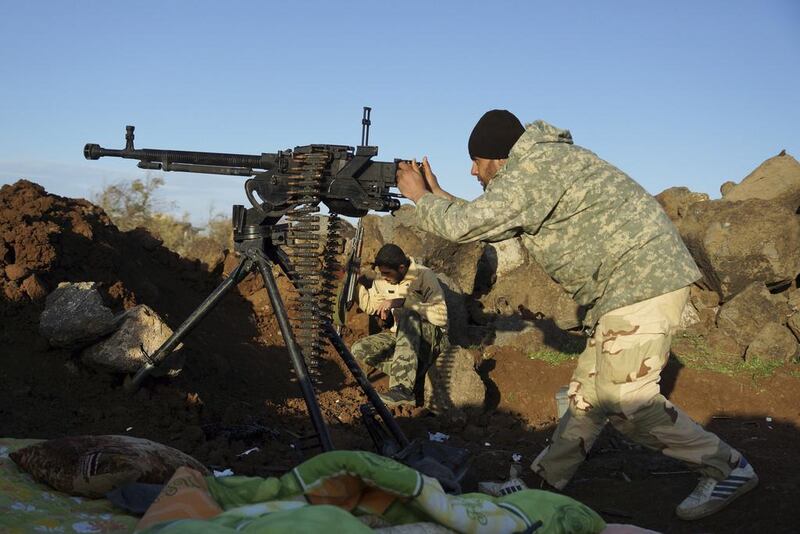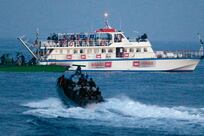Reports emerged last Friday that a leader of one of the largest factions in southern Syria had been ousted by his comrades. The episode is part of a broader campaign that could unravel what is often cited as the most successful model for the rebels across the country.
According to reports from Deraa, the leader of the Syrian Revolutionary Front was pushed aside and replaced by Major Qassem Najm, a military defector.
A source close to the ousted commander confirmed the news and accused Ahrar Al Sham and its regional backers of engineering the move. Last Tuesday, six sub-factions of the revolutionary front issued statements declaring allegiance to Major Najm.
The Southern Front is a rare model for the Syrian rebels. Local groups generally lack a unified command centre, although they collaborate on the front lines throughout the country. Numerous social, political and military factions enabled the groups in the south to coalesce and work towards a relatively moderate and nationalist model under a joint command. Extremist groups largely failed to outperform nationalist forces there, as they did in the north.
Another key factor that differentiates the north from the south in terms of extremist dominance is that backers of the southern coalition have sought to strengthen national forces over Islamist factions. In the north, Turkey’s unbridled support for Islamists created the reverse situation. The two fronts had different sets of foreign backers over the course of the conflict. Qatar and Turkey, for example, had almost uncontested spheres of influence in the northern parts.
The involvement of different foreign backers has also had an effect on which rebel faction dominates where. An obvious example is Ahrar Al Sham, which has failed to establish a meaningful presence beyond the areas bordering Turkey. If the group is powerful, its organisational, ideological and political brand would have helped it attract a following elsewhere, especially since it is known for the financial and logistical support it receives from its backers.
The alternative for extremist groups and their backers is to play a different game. And that seems to be happening in the south, primarily through a campaign to shake up the Southern Front by accusing the rebels of inaction allegedly due to pressure from the United States-led military operations command.
To understand what happened on Friday, take the comments made by Saleh Al Hamwi, a former leader of Al Qaeda’s Jabhat Al Nusra, which was recently rebranded as Jabhat Fateh Al Sham.
Mr Al Hamwi, who is now close to Ahrar Al Sham and its sponsors, made a series of tweets in June, in which he called for a “soft coup” against the Southern Front.
He wrote: “Rebels in Deraa must push aside the notables who support the regime from their tribes. Rebel elites must do the same to the local council members who advocate peace and quiet [with the regime]. Islamist factions must reach out to the honest among the military operations command-backed factions.”
Active battles in the south mean more refugees flow across the border into Jordan. So Amman has supported de-escalation in southern Syria, including an end to Russian airstrikes in rebel areas. Rebels in Deraa dispute the idea that they are prevented by their backers from fighting the regime, citing active fronts across the region.
Rebels there also note that a similar campaign targeted Jaish Al Islam near Damascus even though it does not receive funding from the military operations command. Jaish Al Islam is also rivalled by the same parties that attack the Southern Front.
In June, I warned on this page that the Southern Front has been facing four-way pressure that could lead to its demise. The US-led military operations command seems to have focused on the growing threat of ISIL in southern Syria and has pressed the rebels to root out the group in their midst. A third source of pressure was the coordinated campaign against the Southern Front’s supposed inaction, while the last point of pressure came from local families who support truces and de-escalation.
The coordinated campaign against the Southern Front is also framed in dangerous terms. In mid-July, 54 clerics, including Al Qaeda-affiliated figures but also mainstream Syrian clerics, issued a fatwa prohibiting membership of a rebel faction whose commander refuse to initiate a battle against the regime.
The fatwa specified the Southern Front, albeit such dynamics also exist in the north; activists near Damascus, in response, have asked rebels in the north to focus on regime strongholds within their firing range, such as Foua and Kefraya near Idlib.
Propaganda against the coalition is boosted by the legitimacy of concerns of prioritising the fight against ISIL against the regime, and the risks of the breakdown of the Southern Front are real.
Extremist forces have tried to establish a foothold for themselves in the area, but they often faced tribal, factional and social resistance. Steps have to be taken to prevent extremist forces in their current campaign to buy loyalty where they failed to sell their extremist views.
Hassan Hassan is a resident fellow at the Tahrir Institute for Middle East Policy and co-author of ISIS: Inside the Army of Terror
On Twitter: @hxhassan





